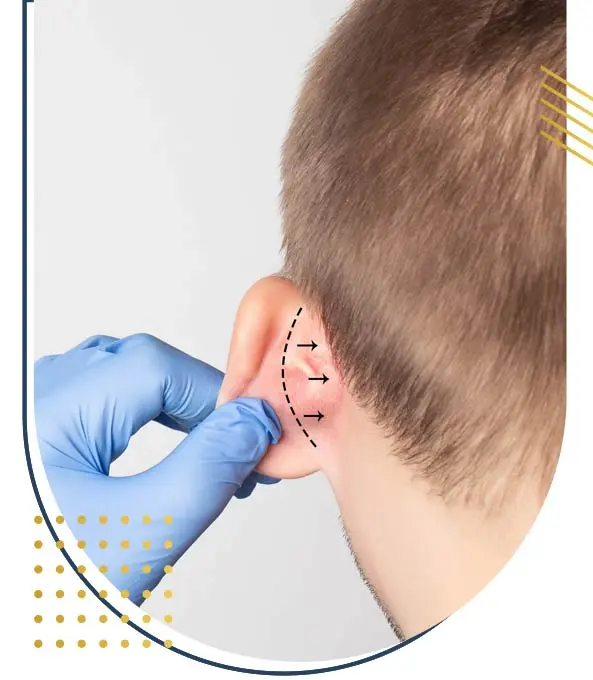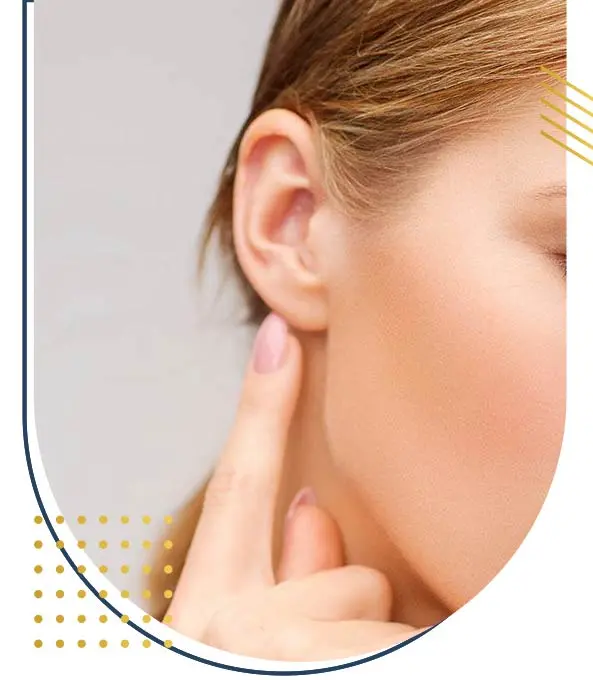
Otoplasty is also called ear correction surgery, it is a cosmetic procedure that consists of correcting the position and shape of the ears.
Its aim is to repair protruding ears by allowing them to be repositioned and reshaped for a more harmonious appearance, so, otoplasty realized in Egypt helps the patient to obtain very good aesthetic results and get rid of this small anatomical particularity which can be a source of discomfort.
Otoplasty price in Egypt
The price otoplasty Egypt is advantageous, you can ask for your free online quote by filling in the quotation request form or contact us by phone and we will give you otoplasty Egypt cost and answer all your questions.
What are the types of the Otoplasty procedure ?
Antihelical Fold Correction Otoplasty :
Antihelical fold correction otoplasty is a surgical procedure designed to address prominent ears by reshaping the antihelical fold.
The antihelical fold is the natural fold found just inside the rim of the ear. When it is underdeveloped or poorly defined, the ear can appear overly prominent.
This type of otoplasty involves making an incision on the back surface of the ear, then carefully reshaping and suturing the cartilage to create a more defined antihelical fold.
During the procedure, the surgeon will typically make an incision on the back surface of the ear, which allows access to the cartilage.
The cartilage is then reshaped using techniques such as scoring, suturing, or cartilage removal to create a more prominent antihelical fold. Once the desired shape is achieved, the incisions are closed with sutures, and a dressing is applied to protect the ear during the initial stages of healing.
After the surgery, patients may experience some swelling, bruising, and discomfort, which can be managed with pain medication and proper care.
It is essential to follow post-operative instructions provided by the surgeon to ensure optimal results and minimize the risk of complications. Over time, as the swelling subsides and the ears heal, patients will notice a significant improvement in the appearance of their ears, with a more balanced and natural contour.

Conchal Reduction Otoplasty :
Conchal reduction otoplasty is a surgical procedure aimed at reducing the size and prominence of the conchal bowl, which is the deepest depression of the ear located just outside the ear canal.
When the conchal bowl is excessively large or protruding, it can contribute to the appearance of prominent ears. This type of otoplasty involves removing excess cartilage from the conchal bowl to create a more proportionate and balanced ear shape.
During the procedure, the surgeon will typically make an incision on the back surface of the ear, which allows access to the cartilage of the conchal bowl. The excess cartilage is then carefully removed or reshaped using surgical techniques such as scoring, suturing, or cartilage excision. The goal is to create a flatter and less prominent conchal bowl that blends harmoniously with the rest of the ear anatomy.
After the surgery, patients may experience some swelling, bruising, and discomfort, which can be managed with pain medication and proper post-operative care. It is essential to follow the surgeon's instructions regarding wound care, activity restrictions, and follow-up appointments to ensure a smooth recovery and optimal results.
Over time, as the swelling subsides and the ears heal, patients will notice a significant improvement in the appearance of their ears, with a more balanced and proportionate contour.
Lobule Reduction Otoplasty :
Lobule reduction otoplasty is a surgical procedure aimed at reducing the size or prominence of the earlobes. The earlobes are the fleshy lower portion of the ear that hangs down and can vary in size and shape from person to person.
In some cases, the earlobes may be excessively large, elongated, or protruding, which can detract from the overall appearance of the ears. This type of otoplasty involves removing excess tissue from the earlobes to create a more proportionate and balanced ear shape.
During the procedure, the surgeon will typically make an incision along the natural crease where the earlobe meets the side of the face.
This allows access to the underlying tissue, including any excess skin or fat that needs to be removed. The surgeon will then carefully trim away the excess tissue and reshape the earlobe to achieve the desired size and contour. In some cases, sutures may be used to support the newly shaped earlobe and promote proper healing.
After the surgery, patients may experience some swelling, bruising, and discomfort, which can be managed with pain medication and proper post-operative care.
It is essential to follow the surgeon's instructions regarding wound care, activity restrictions, and follow-up appointments to ensure a smooth recovery and optimal results. Over time, as the swelling subsides and the ears heal, patients will notice a significant improvement in the appearance of their earlobes, with a more balanced and proportionate contour.
Helical Rim Repositioning Otoplasty :
Helical rim repositioning otoplasty is a surgical procedure aimed at correcting prominent ears by adjusting the position of the helical rim, which is the outer rim of the ear.
When the helical rim is excessively prominent or protruding, it can contribute to the overall appearance of prominent ears. This type of otoplasty involves reshaping and repositioning the helical rim to create a more balanced and natural ear contour.
During the procedure, the surgeon will typically make an incision on the back surface of the ear, which allows access to the cartilage of the helical rim.
The cartilage is then carefully reshaped and repositioned using surgical techniques such as scoring, suturing, or cartilage excision. The goal is to create a flatter and less prominent helical rim that blends harmoniously with the rest of the ear anatomy.
After the surgery, patients may experience some swelling, bruising, and discomfort, which can be managed with pain medication and proper post-operative care. It is essential to follow the surgeon's instructions regarding wound care, activity restrictions, and follow-up appointments to ensure a smooth recovery and optimal results. Over time, as the swelling subsides and the ears heal, patients will notice a significant improvement in the appearance of their ears, with a more balanced and proportionate contour.
Combined Otoplasty Techniques :
Combined otoplasty techniques involve the simultaneous correction of multiple aspects of ear appearance, such as addressing prominent ears, reshaping the antihelical fold, reducing the conchal bowl size, and adjusting the position of the helical rim.
This comprehensive approach allows surgeons to tailor the procedure to the specific needs and aesthetic goals of each patient, achieving optimal results in terms of ear shape and symmetry.
During a combined otoplasty procedure, the surgeon will assess the patient's ear anatomy and discuss their goals to develop a customized surgical plan.
This may involve a combination of techniques such as antihelical fold correction, conchal reduction, helical rim repositioning, and possibly others, depending on the individual's unique anatomy and desired outcome.
The surgical techniques used during combined otoplasty may vary depending on the specific issues being addressed. For example, antihelical fold correction may involve reshaping the cartilage and suturing it into a more defined fold, while conchal reduction may require removing excess cartilage from the conchal bowl.
Helical rim repositioning may involve reshaping and repositioning the outer rim of the ear to achieve a more balanced appearance.
After the surgery, patients will experience some swelling, bruising, and discomfort, which can be managed with pain medication and proper post-operative care. It is crucial to follow the surgeon's instructions regarding wound care, activity restrictions, and follow-up appointments to ensure a smooth recovery and optimal results.
Over time, as the swelling subsides and the ears heal, patients will notice a significant improvement in the appearance of their ears, with a more balanced and proportionate contour.
Otoplasty Egypt :for whom ?
Otoplasty Egypt is for patients who are in a good health.
It is recommended to wait until the age of 7 when the ear is almost fully grown.
It is for those who suffer from prominent ears (which can be a birth defect or caused by an injury or an accident) that can affect them psychologically.
Otoplasty Egypt :how to prepare ?
Before your otoplasty performed in Egypt, you must have a consultation with the surgeon who will examine you, evaluate your health as well as your medical history, he will examine your ears carefully and in details (their size, shape…) and detect the cause of their imperfections.
The most important thing is to clearly define the objectives of otoplasty. The patient must explain perfectly what he or she wants to change.
The surgeon will then explain all the process of this procedure : otoplasty recovery, its results, benefits…
You should stop taking aspirin one month before the intervention
Smoking must also be avoided before and after the operation.
It is recommended to wash the hair and the face the day before the procedure.
the ears should also be washed the same day. Earrings and other piercings should be removed.
How is it performed ?
Many techniques exist, the important thing is to obtain a natural final appearance, free of a certain number of deformations or false folds and harmonious with the face.
Otoplasty realized in Egypt is performed under general anaesthesia.
The surgeon makes an incision in the natural fold behind the ear.
The skin is then peeled away to access the cartilage. The cartilage is then reshaped, either by weakening it with a small curved rasp that follows the shape of the ears (Stenström technique), or by placing non-absorbable stitches (Mustardé and Furnas technique), or a combination of these two techniques.
Depending on the indication to be treated, the surgeon will :
Reshape the cartilage in order to redraw the normal relief or remove part of the overdeveloped cartilage.
Proceed to the folding of the upper part of the ear (the anthelix) and to the burying of the hollow part of the ear (the concha).
The excess skin is removed to avoid creating a bulge. The incision is then sutured with an absorbable thread.
At the end of the operation, the surgeon applies a bandage.
Otoplasty Egypt :aftercare and recovery
After your ear correction surgery in Egypt, the surgeon will prescribe you painkillers to alleviate the pain.
The dressing is removed the following day to be replace by a support bandage (like a tennis bandage) is prescribed for a minimum of 3 weeks to be worn at night to protect the ears.
The sutures are removed spontaneously 2 to 3 weeks after the operation if they are not absorbable.
Bathing in the sea or in a swimming pool is forbidden for about 2 months.
The appearance of an oedema is normal and consecutive to the operation. Bruising may also occur. These effects fade spontaneously with time.
A loss of sensitivity may occur, but this symptom remains transitory.
The patient can resume his professional activities after 2 weeks.
Physical activities are forbidden for up to 1 month (your surgeon will indicate you the period).
The long term healing period.
Removal of Dressings and Sutures :
By one month post-op, any dressings or bandages placed immediately after surgery are usually removed. Additionally, sutures may be removed if they were not dissolvable. This step marks the transition to the next phase of healing, allowing patients to see the initial results of the procedure.
Resolution of Swelling and Bruising :
Swelling and bruising around the ears should significantly diminish by one month post-op. While some residual swelling may persist, especially in the mornings or after physical activity, the majority of the acute swelling should have resolved by this time. Bruising typically fades completely within a few weeks after surgery.
Return to Normal Activities :
Patients can gradually resume their normal daily activities, including work, school, and light exercise, by one month post-op. However, it is essential to avoid activities that could potentially traumatize or injure the ears, such as contact sports or vigorous rubbing.
Follow-Up Appointment with Surgeon :
Around one month after otoplasty, patients typically have a follow-up appointment with their surgeon. During this visit, the surgeon will assess the healing progress, address any concerns or questions the patient may have, and provide further guidance on post-operative care and activity restrictions.
Introduction of Scar Care :
If there are any visible scars from the incisions made during otoplasty, patients may begin scar care treatments as advised by their surgeon. This may include applying silicone gel or sheets to the incision sites to help minimize scar appearance and promote optimal healing.
Monitoring of Results :
By one month post-op, patients should have a good sense of the initial results of the otoplasty procedure.
While the ears may still appear slightly swollen or asymmetrical, the overall shape and position should be significantly improved compared to before surgery. It is essential to maintain realistic expectations and understand that final results may take several months to fully manifest as residual swelling continues to resolve.
Continued Follow-Up and Monitoring :
Following the one-month mark, patients should continue to attend scheduled follow-up appointments with their surgeon as recommended. These appointments allow the surgeon to monitor the long-term healing progress, address any concerns that may arise, and ensure that the final results meet the patient's expectations.
Patience and Persistence :
Long-term healing and final results from otoplasty can take several months to a year to fully manifest. It is essential for patients to be patient and persistent in adhering to post-operative care instructions, attending follow-up appointments, and practicing good scar care techniques to optimize the outcome of their otoplasty procedure.
Otoplasty Egypt results
The final results of otoplasty realized in Egypt will be appreciated after a few months.
This surgery definitively corrects ear imperfections by remodelling and repositioning the cartilage so as to obtain symmetrical, well-folded, non-hypertrophic ears of natural size and in perfect harmony with the whole face.
This intervention allows the patient to regain self confidence.
What are the risks of the Otoplasty procedure ?
Infection :
As with any surgical procedure, there is a risk of infection following otoplasty. This risk can be minimized by following proper post-operative care instructions, including keeping the surgical site clean and taking prescribed antibiotics if necessary.
Bleeding :
Bleeding can occur during or after surgery, leading to hematoma formation (a collection of blood under the skin). This risk is typically minimized through careful surgical technique and post-operative monitoring.
Pain and Discomfort :
It is common to experience pain, discomfort, and soreness in the ears following otoplasty. This can usually be managed with pain medication prescribed by the surgeon.
Swelling and Bruising :
Swelling and bruising are common side effects of otoplasty and can persist for several weeks after the procedure. While they are typically temporary, they can affect the appearance of the ears during the initial stages of healing.
Scarring :
Otoplasty involves making incisions on the back surface of the ears, which can result in visible scars. While efforts are made to minimize scarring and place incisions in discreet locations, individual healing characteristics may vary.
Asymmetry :
Achieving perfect symmetry between the ears is challenging, and there is a risk of slight asymmetry following otoplasty. While surgeons strive for symmetrical results, minor differences in ear shape or position may occur.
Overcorrection or Undercorrection :
There is a risk of overcorrection (making the ears appear too pinned back) or undercorrection (insufficient correction of prominent ears) following otoplasty. Surgeons work closely with patients to establish realistic expectations and achieve the desired outcome.
Numbness or Altered Sensation :
Some patients may experience temporary numbness or altered sensation in the ears following otoplasty. This typically resolves as the nerves heal but can persist in rare cases.
Allergic Reactions :
Allergic reactions to anesthesia, sutures, or other surgical materials used during otoplasty are rare but possible. Patients should inform their surgeon of any known allergies before the procedure.
Delayed Healing :
In some cases, the ears may take longer to heal than expected, leading to delayed wound healing or prolonged recovery. Patients should closely follow post-operative care instructions to promote optimal healing.

Skin Discoloration :
Changes in skin color or pigmentation may occur around the surgical site following otoplasty. While these changes are usually temporary, they can affect the cosmetic outcome in some cases.
Revision Surgery :
In some instances, additional surgery may be necessary to achieve the desired results or address complications such as asymmetry or overcorrection. Revision surgery carries its own set of risks and considerations.
Anesthesia Risks :
General anesthesia, which is commonly used for otoplasty, carries its own set of risks, including allergic reactions, respiratory problems, and adverse reactions to anesthesia medications.
Persistent Dissatisfaction :
Despite the best efforts of the surgeon, some patients may be dissatisfied with the results of otoplasty. It is essential for patients to have realistic expectations and communicate openly with their surgeon about their goals and concerns.

